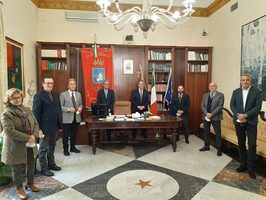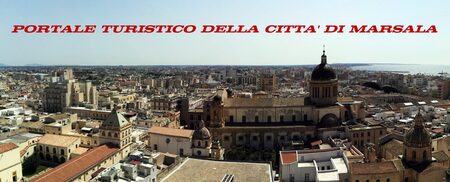
Cultura e Turismo
continua articolo da home page
...
Terra di Sicilia, leggendaria,sorge su Capo Boeo, punta estrema dell'Italia. Lega il suo nome al vino marsala e alla storia della nostra Repubblica che da qui, l'11 Maggio 1860, Garibaldi avviò verso l'unificazione. Fare due passi nel Cassaro o un'escursione fuori dalle storiche Porte, dà l'idea delle risorse e delle bellezze di Marsala, la quinta della Sicilia per popolazione con più di 85 mila abitanti.Si scopre così una città mediterranea e moderna, che si divide tra mare e terra: anzi, la sua stessa storia è un rincorrersi di entrambi, prima di trovare nel vino la sua naturale sintesi. I Fenici giungono dal mare per insediarsi nella vicina isola di Mozia,la perla archeologica nella laguna dello Stagnone distrutta nel 397 a.C. I superstiti si trasferiscono sulla terraferma e fondano Lilybeo, poi passata sotto i Romani. Ancora dal mare arrivano gli Arabi (VIII secolo) che ribattezzano la città Marsa Allah da cui ha origine l'attuale nome. Quindi è la volta di Normanni, Svevi, Angioini che fanno di Marsala un fiorente centro agricolo: nascono feudi, si diffondono le colture di cereali. L'arrivo degli Spagnoli (1575) segna il declino delle attività legate al mare per la scellerata chiusura del porto.Il mare ridiventa protagonista della storia della città quando il commerciante inglese John Woodhouse spedisce un carico di vino a Liverpool: è il 1773, l'anno di nascita del vino marsala.Nel nome di questa nobile Doc, mare e terra si ritrovano in un felice connubio a tutto vantaggio dell'economia della città che comincia ad attirare uomini d'affari. Per primi sono gli Inglesi; poi arrivano i Florio. Quasi a metà dell'800, il marsala diventa una storia italiana, suggellata più tardi dall'impresa dei Mille garibaldini cui si uniscono i picciotti siciliani. Il resto, è la storia recente di una città che vuole ricavarsi un ruolo nell'area del Mediterraneo. Con una propria identità,che affiora tra l'antico e il moderno.Marsala conserva innumerevoli testimonianze. Il patrimonio artistico è ampio, con santuari e grotte, ipogei e strade sommerse, necropoli e terme,relitti di navi e anfore.Nel museo di Baglio Anselmi si custodiscono i legni della più antica nave punica da guerra, nonché i preziosi reperti delle recenti scoperte venuti alla luce nel Parco archeologico, le statue della Venere callipige e di Iside. Le strade, dove si affacciano antichi palazzi nobiliari e in stile barocco, conducono il visitatore tra imponenti chiese, monumenti e le opere d'arte del Convento del Carmine; gli arazzi fiamminghi del Museo della Madrice e i bellissimi affreschi del Teatro comunale. Le testimonianze fenicio-puniche e romane sono concentrate nel cuore antico della città e, soprattutto, nell'isola di Mozia (San Pantaleo), l'antica città fenicia teatro di tante battaglie - raggiungibile in pochissimi minuti dalla terraferma -custode dell'imponente statua in marmo del giovane auriga Alcimedonte.
Marsala stands on the extreme western tip of the land of legends, Sicily. Its name is linked to marsala wine and tothe history of our Republic, when - on 11th May 1860 - Garibaldi started his march towardsthe unification of Italy. A stroll along the main shopping street (the cassaro)or a walk outside the city gates, will give you an idea of the resources and beauty of Marsala, the fifth largest city in Sicily with 85,000 inhabitants.So, you will discover a modern,mediterranean city, divided between land and sea; indeed, both are interwovenwith its history until wine became a dominant figure. The Phenicians settled onthe nearby island of Mozia, which is the archaeological treasure in the Lagoon of the Stagnone and was destroyed in 397 B.C. The survivors escaped to the main land and founded Lilybaeum, which then passed under Roman rule. Arabpirates (VIII Century) renamed the town Marsa Allah, from which it takes its present name. Then, came the Normans, the Swabians, the Angevins, who turned Marsala into a flourishing wheat-growing area. The decline of seafaring activiti esbegan with the arrival of the Spanish who closed the Port.The sea became important once again when the English man John Woodhouse started exporting wine to Liverpool in 1773. This was the birth of marsala wine. So, both sea and land joined together to the advantage of the economy of the town, which soon attracted other merchants. First theEnglish; then the Florio. In 1860Marsala became part of Italian history, when Garibaldi and the Thousand landed in Marsala and were joined bythe local men. The rest is the recent history of a town which wants to cut outits rightful role in the Mediterranean; a role with its own identify, between ancient and modern.Marsala has innumerable tokens of the past. Its artistic heritage is vast: sanctuaries, grottos hypogeums,necropolis, Roman baths, shipwrecks and amphorae.The planks of the oldest PunicWarship ever found are on display in the Baglio Anselmi Museum, which also contains other preciousrecent finds such as the statues ofVenus Callipige and Isis. The streets, lined by baroque houses, lead thesightseer to imposing churches, monuments, the works ofart in the "Convento del Carmine", the Flemish Tapestries in the museum of the Cathedral and the beautiful affrescoes in the municipal theatre. The Phoenicio-Punic and Roman remains areconcentrated in the old town centre and, overall, on the island of Mozia (SanPantaleo) which was the theatre of many battles. Mozia can be reached by boatin a few minutes and a marble statue of the young charioteer Alcimedonte can be admired in the museum.
Un cuore antico - An ancientheart
Quasi interamente recuperato,racchiuso tra vecchie mura e antichi bastioni, il cuore antico di Marsala pulsa in Piazza Loggia. In questa suggestiva cornice architettonica svettano maestosi la Cattedrale (dedicata a San Tommaso Becket) e il Palazzo VII Aprile (che ricorda i primi moti rivoluzionari dell'800). Il Cassaro, oggi via XI Maggio, spacca in due il centro. Da un lato il quartiere spagnolo con la storica Porta di Mare, il Santuario dell'Addolorata e la Chiesa del Purgatorio, Piazza San Girolamo e quella del Carmine con il campanile a scala elicoidale. Dall'altro, il quartiere ebraico dove sorge il cinquecentesco Complesso San Pietro a torre cuspidata e, poco distante, il Santuario della Madonna della Cava, patrona della città.Proseguendo lungo la via XI Maggio, tra viuzze e cortili, lo sguardo viene catturato dal settecentesco Palazzo Fici e da Porta Nuova. È questo l'ingresso nell'area archeologica di Capo Boeo, con l'antica strada romana, il decumano maximo, e la chiesa dedicata a San Giovanni Battista edificata sopra la Grotta della Sibilla lilibetana: un suggestivo ipogeo dove tuttora sgorga una sorgente d'acqua dolce, fonte divi ta dei primi abitanti della città.
It is enclosed by ancient defense walls and most of the old buildings have been restored. The real heart of the city is Piazza Loggia. The square is dominated by the Cathedral of St Thomas Becket and Palazzo VII Aprile (which commemorates the first revolution in the 1800's). Today via XI Maggio cuts the city into two parts.One part is the Spanish Quarter with its "Porta a Mare" the Santuario dell'Addolorata and the church of Purgatory. Piazza San Girolamo and Carmine with its bell-tower. The other part is the Jewish quarter where the 16th century San Pietro complex rises and nearby the sanctuary of the Madonnadella Cava, patron of the town.Continuing along via XI Maggio, our eye iscaught by 18th century Palazzo Fici and Porta Nuova. This city gate is the entrance to the archaeological area of Capo Boeo, which contains the RomanStreet (decumano maximo) and the church dedicated to St. John the Baptist,built above the Lilybaeum Sybil's grotto. There is still a fresh - water springin this evocative hypogeum.

